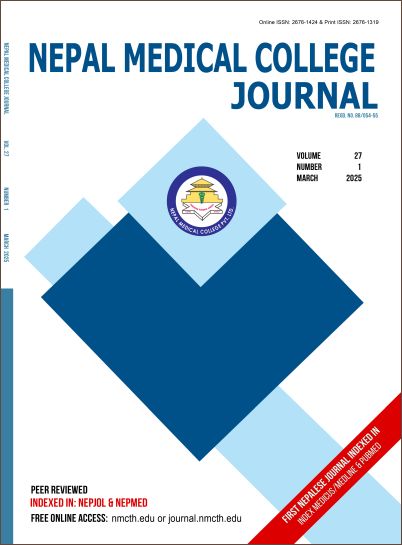Patterns of Sexually Transmitted Infections in a Tertiary Care Hospital: An Alarming Rise in the Prevalence of Syphilis
DOI:
https://doi.org/10.3126/nmcj.v27i1.77545Keywords:
Serology, sexually transmitted diseases, syphilisAbstract
It is essential to know the current patterns of sexually transmitted infections (STIs) for planning and implementing strategies. Recently, syphilis seems to be increasing in number but has not been documented. The objective of this study was to study the patterns of STIs in patients attending dermatology and venereology outpatient department of a tertiary care hospital. This was a cross-sectional study of the data obtained retrospectively from the records of STI cases attending the dermatology and venereology outpatient of a tertiary care hospital in Kathmandu from 1st April 2024 to 30th September 2024. The demographic details, clinical diagnosis, and investigation findings were extracted from the records and analyzed using SPSS 26. One hundred and sixty-three cases of STIs attended the dermatology outpatient department, 110(67.5%) were males and 53(32.5%) were females. The age of presentations ranged from 17 years to 75years. Maximum number of cases (n=62, 38%) were in the age group of 15 to 25 years. Syphilis was the most common diagnosis (n=112, 68.7%), with hospital -based prevalence of 1.2% with male predominance. Late latent syphilis was more common among syphilis accounting for 38.4%(n=43) of all syphilis. Condyloma acuminata (n=25, 15.3%) was the second most common STI followed by gonorrhea (n=12,7.4%). In conclusion, syphilis was the common presentation in our study followed by condyloma acuminata and gonorrhea. Late latent cases were the most common presentation within the cases of syphilis. STIs were common in young age and male sex.
Downloads
Downloads
Published
How to Cite
Issue
Section
License
Copyright (c) 2025 Nepal Medical College Journal

This work is licensed under a Creative Commons Attribution 4.0 International License.
This license enables reusers to distribute, remix, adapt, and build upon the material in any medium or format, so long as attribution is given to the creator. The license allows for commercial use.




